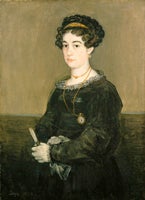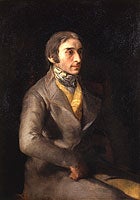|
For more information, see the related essay about Self-Portraits and Portraits.
 |
|
Self-Portrait with Three-Cornered Hat
c. 1780–92
Pen and brown ink, with framing line in black chalk, on paper
The Metropolitan Museum of Art, New York, Robert Lehman Collection, 1975
[cat. no. 1] |
Here Goya depicts himself in his mid-thirties or early forties,
in the prime of his life. The forceful, vibrant lines of the
costume convey a sense of robustness. He looks at the
viewer wearing a jaunty three-cornered hat, which imparts
a raffish air.
 |
|
Self-Portrait after Illness of 1792–93
c. 1795–97
Brush and gray wash on paper
The Metropolitan Museum of Art, New York, Harris Brisbane
Dick Fund, 1935
[cat. no. 2] |
The artist registers the effects of his serious illness of
1792–93 in this moving self-portrait made with a pointed
brush and gray wash. His intense, inward gaze suggests a
sense of isolation. This image has frequently been compared
to those of his contemporary Beethoven after the composer’s
loss of hearing. Goya’s unruly locks of hair and bushy sideburns
exude a sense of energy.
 |
|
Self-Portrait with Dr. Arrieta
1820
Oil on canvas
The Minneapolis Institute of Arts, The Ethel Morrison Van Derlip Fund
[cat. no. 3] |
In this remarkable work, Goya portrays himself as pale and
collapsing—at death’s door—supported on the arm of his
young physician, who offers a healing medication. The
arrangement of figures evokes the traditional composition
of the pietà. Three mysterious beings lurk in the dark background,
one of them holding a vessel suggestive of a chalice.
Goya’s inscription reads: “Goya, in gratitude to his friend
Arrieta: for the skill and care with which he saved his life in
his acute and dangerous illness suffered at the end of the
year 1819, at the age of seventy-three. He painted it in 1820.”
 |
|
Javier Goya (Francisco Javier Pedro Goya y Bayeu)
1824
Graphite on paper
Private collection, courtesy The Metropolitan Museum of Art,
New York
[cat. no. 4] |
Javier Goya was the only one of the artist’s six children to
survive beyond childhood. Although he was occasionally
referred to as a painter, there are no known works attributed
to him. He lived off his investments and the sale of his
father’s paintings. The slack folds of flesh and melancholic
expression of his forty-year-old son contrast with the vigorous
image Goya made of himself at about the same age (cat.
no. 1). He may have made this drawing as a keepsake to
take into exile with him.
 |
|
Don Tiburcio Pérez y Cuervo, the Architect
1820
Oil on canvas
The Metropolitan Museum of Art, New York, Theodore M. Davis
Collection, Bequest of Theodore M. Davis, 1915
[cat. no. 5] |
Soon after his recovery from serious illness in 1819, Goya
painted this portrait of a young friend in Madrid. The architect’s
informal stance and stylish black and white attire —
standard dress for men after the French Revolution — mark
him as one of the “new men” of the emerging professional
class. The work is executed with a minimum of paint, using
a restricted palette. In its simplicity of means, vigorous handling
of paint, and candor, this portrait opens the way to
Goya’s late portraits of friends and supporters.
 |
|
José Duaso y Latre
1824
Oil on canvas
Museo de Bellas Artes, Seville
[cat. no. 6] |
When Ferdinand VII unleashed a reign of terror against the
Liberals in 1824, this Aragonese priest offered Goya refuge
in his quarters in the Hospital del Buen Suceso, Madrid,
shortly before he left Spain. Two medals—the larger of
which is the Order of Charles III—adorn the cleric’s garb.
The focus of the work is on the character of Goya’s courageous
friend, conveyed through the intensity of his absorption
in his reading.
 |
|
Portrait of a Lady (María Martínez de Puga?)
1824
Oil on canvas
The Frick Collection
[cat. no. 7] |
Mystery surrounds the sitter, who is provisionally identified
as the wife of a witness to a power-of-attorney executed by
Goya before leaving Madrid. Neither is it known whether
Goya painted the work in Madrid, Paris, or Bordeaux, the
cities where he spent time in the pivotal year of 1824.
With its subdued palette and daring, informal technique,
the portrait has long been recognized as a masterpiece of
the final years.
 |
|
Joaquín María de Ferrer y Cafranga
1824
Oil on canvas
Private collection
[cat. no. 8] |
A native of the Basque province of Guipúzcoa, Ferrer made
a fortune in Latin American trade. His outspoken Liberal
views earned him a death sentence from Ferdinand VII.
Goya met him in Paris, where he painted this portrait and a
companion piece of his wife. The work is remarkable for its
naturalness and directness of expression. The sitter appears
to be lost in contemplation of the lines he is reading.
 |
|
Manuela de Álvarez de Coiñas y Thomas de Ferrer
1824
Oil on canvas
Private collection
[cat. no. 9] |
In composition, this portrait is similar to that of María
Martínez de Puga, painted the same year. Both women are
dressed in the same fashion. Mrs. Ferrer’s rounded forms
and slight acknowledgment of the viewer convey a sense of
softness and warmth that complement the more austere
appearance of her husband. The sitter’s face is slightly
abraded.
 |
|
Leandro Fernández de Moratín
1824
Oil on canvas
Museo de Bellas Artes, Bilbao
[cat. no. 10] |
The Spanish poet and playwright Moratín was as well
known in the literary world as was Goya in visual art. The
unremitting interference of the Inquisition in his work
prompted his departure from Spain in 1821. He settled in
Bordeaux and was at the center of Goya’s life there. Soon
after Goya’s arrival, Moratín wrote to a friend: “He wants
to do my portrait; from that I infer how pretty I am when
such skilled paintbrushes aspire to multiply my copies.”
 |
|
Manuel Silvela
1824–27
Oil on canvas
Museo Nacional del Prado, Madrid
[cat. no. 11] |
Manuel Silvela was a judge in the court of Joseph Bonaparte
during the French occupation. With the departure of the
French in 1813, he left for Bordeaux and established a
successful school for the children of Spanish and Latin
American émigrés. Goya lavished attention on the sitter’s
head and foulard, although the lower part of the painting
remains unfinished. The concentrated facial expression and
gesture of the hand convey the intense character of this
erudite schoolmaster.
 |
|
Milkmaid of Bordeaux
c. 1827
Oil on canvas
Museo Nacional del Prado, Madrid
[cat. no. 12] |
This image of a pensive young woman, with a milk jug at
her side and thought to be seated on a donkey, is one of
Goya’s final achievements in painting. With its loose, sketchy
brushwork and light tones, it has sometimes been described
as a precursor to French Impressionism. It is included here
as a signature work of Goya’s Bordeaux years. The Milkmaid was left to Leocadia Zorrilla, who sold it to raise money in
1830.
|


